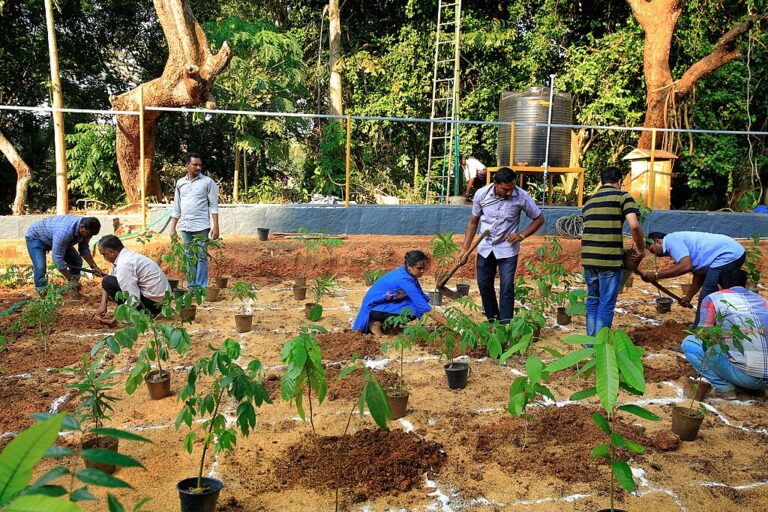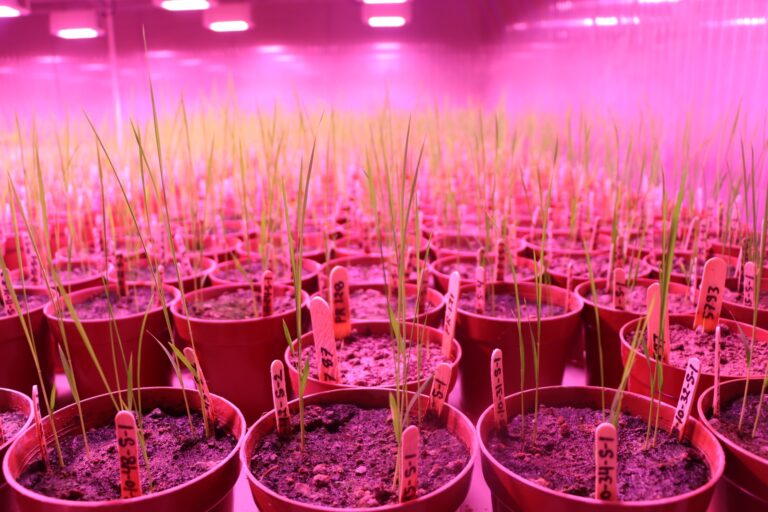- The cyclone-prone village of Jharkhali in the Sundarbans region is planting mangroves to protect itself against the impact of the increasing number of cyclones in the area.
- Mangroves are natural barriers against climate disasters and help hold back the strong blows of the high tidal waves. The river embankments are protected as the roots of mangroves grip the earth and prevents landslides.
- The women of Jharkhali Sabuj Bahini, an NGO formed in June 2005 and led by Akul Biswas, a visually challenged person, have been at the forefront of the mangrove plantation efforts that they carry out independently.
When cyclone Yaas hit on May 26, it inundated several coastal villages in the Sundarbans region in West Bengal. Jharkhali, a low-lying village in South 24 Parganas district of West Bengal, however, did not face a strong impact. The storm neither breached the river embankment nor rendered the residents here homeless, as it did elsewhere. Surrounded by three sides with rivers Matla, Bidyadhari and Herobhanga, the region is cyclone prone and the villagers have previously witnessed cyclones including Aila (May 2009), Fani (May 2019), Bulbul (November 2019), Amphan (May 2020), before Yaas in May 2021.
The protection from Yaas can, in part, be credited to the mangrove saplings that the villagers of Jharkhali have grown at the embankment, meant as a coping mechanism against cyclones and tidal waves. Around 300,000 mangrove saplings have been planted here since 2017.
Much of this is because of the efforts of the women of Jharkhali Sabuj Bahini, an NGO formed in June 2005 and Akul Biswas, 47, a visually challenged person, who led the villagers, mostly homemakers and widows, to form this group and take up the plantation efforts.
Born in a farmer’s family, Biswas is the youngest among four siblings. He lost his vision owing to glaucoma and could not complete his education. After a difficult phase in life, he found his calling in environment protection through plantations.
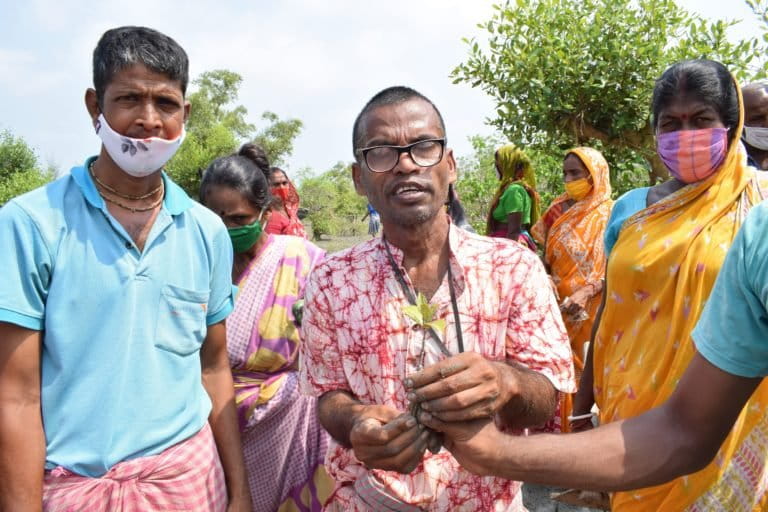
Initially, he began planting trees on the roadsides. But cyclone Aila in 2009 taught him a lesson. “Aila wrecked us badly. The embankment in our region was engulfed by the surge that led to inundation with water. It damaged homes, uprooted trees, electric poles, destroyed agricultural land, cattle washed away and sweet water fish found dead,” Biswas, who is the Founder President of Jharkhali Sabuj Bahini [Jharkhali Green Army], told Mongabay-India.
“What I noticed was that the water entered through the sparse area that barely had any mangroves. I decided to fill those gaps and began planting mangrove to save our regional surroundings,” he added.
When he started planting mangrove saplings on the bank of the river Bidyadhari along with some children, some homemakers, disabled persons and widows who lost their husbands to tiger attacks, joined his campaign.
“We are willingly doing this plantation with the purpose of shielding ourselves from the fury of natural calamities. Mangrove protects both landslides and loss of lives,” says 50-year-old volunteer Santi Das.
She added that the tiger took away her husband two-and-a-half years ago, when he went to the forest to fetch honey. Human-tiger conflict is a regular occurrence in the Sundarbans with many women losing their husbands to these attacks. Despite the threat of wild animals and snakes the people continue to carry out the plantation work in groups as a precautionary measure.

The green soldiers
The Sundarbans forest region, straddling India (West Bengal) and Bangladesh is about 10,000 square km. The mangrove cover in the Indian Sundarbans spans roughly 2107 square km. The Sundarbans mangroves harbour 34 true mangrove plants and associate plant species.
Biswas and his team in Jharkali grow around 10 species of mangroves: Sundari (Heritiera fomes), Goran (Ceriops decandra), Keora (Sonneratia apetala), Dhundul (Xylocarpus granatum), Pashur (Xylocarpus mekongensis), Kankra (Bruguiera gymnorrhiza), Khalsi (Aegiceras cornicula), Peara baine (Avicennia marina), Golpata (Nypa fruticans) and Bhara (Rhizophora mucronata).
The mangroves help hold back the strong blows of the high tidal waves. The river embankments are protected as the root of these mangroves grips the earth tight and that resists landslides.
“Besides, the mangrove is the only plant species which has the maximum capacity to inhale carbon dioxide. The suction capacity is found more in the mangrove leaves compared to the freshwater green leaves. The sour fruit draws more carbon dioxide,” informs Biswas.
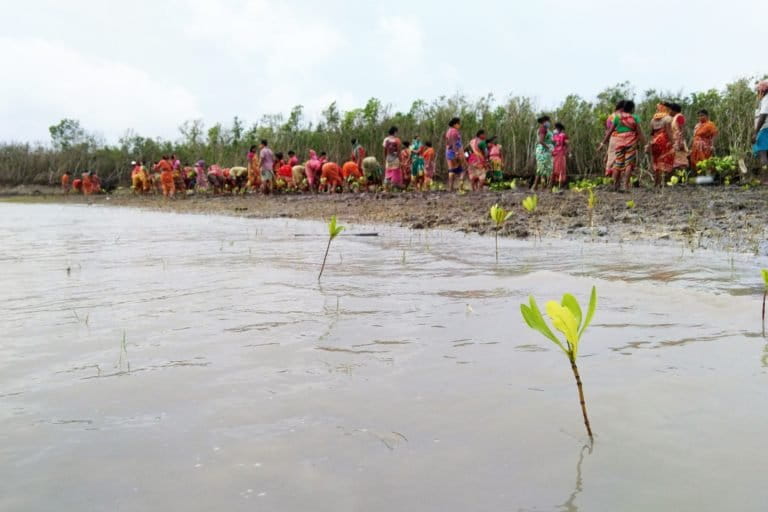
A retired school teacher, Dhiman Biswas, who is also an elderly volunteer, recalled how cyclone Aila flooded their village and damaged agri-land when water receded. They could cultivate nothing for the next three years due to salinity. But cyclone Yaas failed to harm them this year.
“Mangrove trees are the green soldiers deployed to defend us from disaster,” says Dhiman Biswas. He also stated that the state Forest Department does plantations in the deep forest. “We are no match with them in all respects. They have infrastructure, manpower and money. Let the government do its job and we should support the authority. We are doing it for our own sake, for our own safety and for our own ecosystem,” he adds.
Mangrove forests, nature’s buffer against disasters, are imperiled by unregulated coastal development, shrinking of deltas and climate change linked extreme events. The degrading health of mangroves affects their resilience and recovery potential against climate change consequences like sea-level rise.
Plantation methods
A couple of methods are applied to grow mangrove saplings. One mode is to collect fruits or seeds and develop those into saplings while the other technique is to collect and plant them directly on the river bank, which is an easier process. But the quality of fruits is not predictable. The fruit may produce a mangrove plant or may not grow at all. Over 200,000 such seeds (aside from sapling plantation) have been grafted in the past two years.
Talking to Mongabay-India, the secretary of Jharkhali Sabuj Bahini, Prasanta Sarkar said that their volunteer team keeps track of the rivers to collect floating seeds. After collection, the seeds are picked for processing to grow saplings because not all the kernels are suitable for germination.
“We keep aside the good seeds for the nursery. The seeds are inserted into a plastic pouch filled with soil. The buds grow six inches tall within three months. Then the ready saplings are carted to the riverside. Notably, the mangrove can survive in sweet water but it won’t have the growth,” said Sarkar.
Before plantation, the scanty zones are first identified and then a slope is prepared because not all saplings can grow where water level is high. Species like baine, keora, bhara and kankra are planted one after the other.
The saplings of baine mangrove can be planted on the river bed where water level is at least knee-deep, while sundari mangrove cannot be grown where the level of water is high. These saplings require a minimum 3-5 years to grow into trees.
The saplings are planted at a gap of one foot or between two and four feet distance and in the direction of the river to prevent water seepage. The bottom line is to create a natural wall that obstructs waves from hitting the embankment.
Around 80 percent of the saplings planted by the group have become fully-grown trees. The rest get damaged for various reasons like the root may get broken while inserting into the soil, tender leaves are chewed by goats and cows or humans errantly walk over the tender saplings.
The season starts from the month of June when volunteers began searching for the fruits. The seedling processing at the nursery is between July and September. And then plantation is from October to January.
The women devote around two hours a day and can plant around 200-250 saplings in a day. They do it free of cost, discloses Sarkar.
“We cannot afford to pay. We have around 80 widows and over 100 homemakers giving their blood, sweat and tears. We distribute some relief materials being contributed to us by Goonj, a Delhi-based NGO. In lieu of cash, we offer them sari, rice, puffed rice, pulses, soya bean, toothpaste, flour, sattu, blanket, etc., twice a year,” Biswas told Mongabay-India.
“We don’t expect wages. Our social responsibility is to develop Sundarban as an environment-friendly region. We can maintain the ecological balance of this forest zone more with more mangroves plantation,” shares Malati Mondal, a volunteer.
Awareness among the other villagers
“The women are playing an important role in environmental protection. They have set an example for those in other villages in this coastal area,” avers Biswas.
As of now, the plantation for protection of the embankment is underway at Basanti block, which has four gram panchayats with 42 villages, besides six villages at Kultali block and 24 villages at Gosaba block. “We will continue the same way in the future as well. This is how we are generating awareness among the villagers. We invite more people to join us,” Sarkar announces.
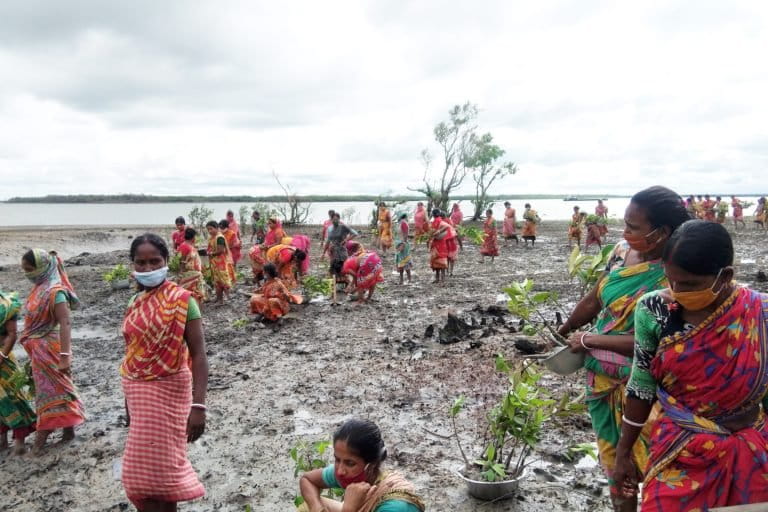
In terms of funding, Sarkar said that completely rely on resources in Sundarbans made available to them – freely available fruits (seeds) and agri-soil for nursery. They also have arranged for free transportation while plantation and safeguarding the property is also done voluntarily. “It’s not that we don’t require funds. We could financially help our volunteers and could afford biodegradable gunny pouches instead of plastic for germinating seedlings with funds,” admits Sarkar.
Banner image: Mangrove seeds. The women of Jharkhali Sabuj Bahini, led by Akul Biswas, a visually challenged person, have been planting mangroves in Jharkali village. Photo by Partho Burman.






